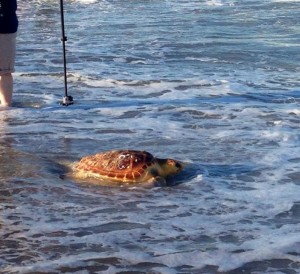
ASSATEAGUE — Four loggerhead turtles rescued last winter in Cape Cod after falling victim to the annual “cold-stunned” phenomena were released from the beach at the Assateague State Park on Sunday evening.
Throughout the late fall and winter, hundreds of sea turtles are discovered and rescued from beaches up and down the mid-Atlantic region including some in Ocean City and Assateague after suffering from hypothermia and a phenomena known as cold-stunning. The sea turtles often hit patches of extremely cold water in their typical migration patterns to warmer climates and the cold water literally stuns them to the point their bodies start to shut down and they wash up on the beaches.
In many cases, the cold-stunned turtles are rescued by marine animal rescue programs, such as the MARP program maintained by the National Aquarium in Baltimore, which monitors the mid-Atlantic beaches including Ocean City and Assateague. The rescued turtles are taken to rehabilitation centers up and down the coast where they are nursed back to health to the point they can be re-released.
While the mid-Atlantic beaches see their fair share of cold-stunned sea turtles each winter, the problem is typically more acute further north, particularly in New England. On Sunday, four loggerhead turtles rescued near Cape Cod and rehabilitated all winter and spring at the New England Aquarium and the University of New England were successfully released from the beach at Assateague State Park.
“Every year, the biggest stranding events we face are cold-stunnings,” said New England Aquarium spokesman Tony LaCasse this week. “We have anywhere from 50 to 250 each year depending on a variety of factors.”
The four loggerhead turtles released from the beach at Assateague on Sunday were juveniles rescued near Cape Cod late last fall. They were rescued after getting caught up in a typical problem area the New England Aquarium deals with each winter.
“There are a lot of juvenile sea turtles just north of the cape, which is a very large bay about 40 miles across,” said LaCasse. “They go in there to feed in the summer and they can’t figure out how to get out. By the time they figure it out and get out of the bay, the water north of the cape is so cold they get stunned and suffer hypothermia.”
The four loggerheads released on Sunday from Assateague were named Andes, Candy Cane, Sugar Plum and Maple. Each year, the New England Aquarium comes up with a theme to name their rescued sea turtles and this year had a candy theme.
The National Aquarium in Baltimore also released some of its rehabilitated cold-stunned turtles over the weekend at different locations around Maryland. The National Aquarium’s theme this year was the movie “Top Gun” and thus turtles with names like Maverick, Chipper, Charlie and Tombstone, for example, were released.
The four loggerheads released from Assateague on Sunday were treated and stabilized first at the New England Aquarium and later transferred to the University of New England in Maine for further rehabilitation. LaCasse explained the four turtles were transferred to the university because the aquarium was filled to capacity with cold-stunned turtles.
After they were rehabilitated, the four turtles- Andes, Sugar Plum, Candy Cane and Maple- were transferred recently to Virginia where they could begin the become acclimated again to warmer water. Once they were re-acclimated to warmer water, they were ready for re-release into the open ocean. LaCasse said the New England Aquarium team brought the rehabilitated turtles to Assateague via a caravan of trucks on Sunday and released them from the beach around 6 p.m. with a big crowd of onlookers on hand.0
“When they get out on that beach and that first breeze off the water hits them, you can see them get instantly enervated,” he said. “They all went easily down to the water and you could see they were energized by the sea breezes.”
LaCasse said the rehabilitated sea turtles weren’t the only ones energized by the gentle sea breezes on Assateague.
“Assateague has always been on my list because I’ve heard so much about it, and when we get there, we literally see wild horses grazing,” he said. “The Park Service folks were incredible and our friends at the National Aquarium were there to support and set up the beach for the releases.”
LaCasse said two of the released turtles, Sugar Plum and Maple, were fitted with satellite tags that will help researches gain a better understanding of their locations, migration patterns and feeding habits.
“We’ll be able to see if they hang around Assateague, or maybe migrate into the Chesapeake, or even head north again,” he said. “The tags will give us a wealth of knowledge to better understand them.”
